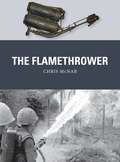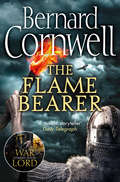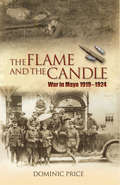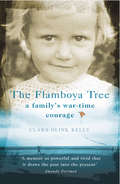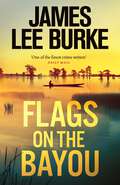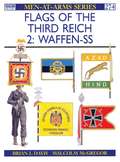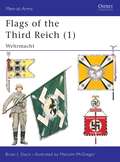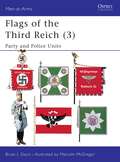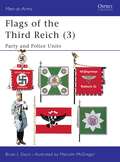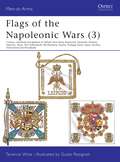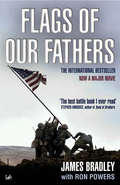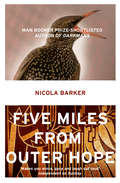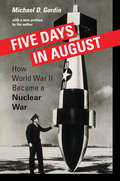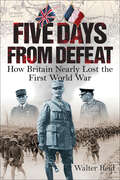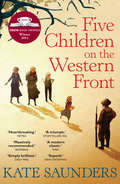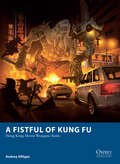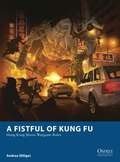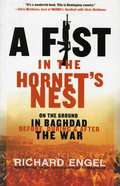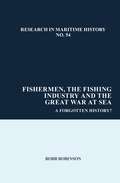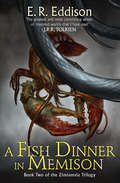- Table View
- List View
The Flamethrower (Weapon #41)
by Steve Noon Chris McNab Alan GillilandThe focus of this book is a weapon that has literally placed the power of fire in human hands – the man-portable flamethrower. This formidable weapon first saw battlefield use in the hands of German troops during World War I, and went on to arm the forces of many countries in World War II and beyond. Capable of inflicting horrific injuries – or of using up the oxygen supply inside a building, causing the occupants to suffocate – it projected a stream of flammable liquid, which could be 'bounced' off the interior surfaces of tunnels, buildings and other defended structures to reach deep inside a fortification.From its combat debut to its deployment in Vietnam, Chechnya and elsewhere, the flamethrower has proven to be devastatingly effective, not least because of its huge psychological impact on enemy troops. Yet despite this, the weapon and its operators have always been vulnerable, suffering from a very particular set of limitations, all of which are explored here. Featuring expert analysis, first-hand accounts and a startling array of illustrations and photographs, this is the definitive guide to an extraordinary chapter in the history of military technology.
The Flame Bearer (The Last Kingdom Series #10)
by Bernard CornwellThe tenth book in the epic and bestselling series that has gripped millions. A hero will be forged from this broken land. As seen on Netflix and BBC around the world.
The Flame and the Candle: War In Mayo 1919-1924
by Dominic PriceThis is the story of Mayo men and women active during the War of Independence and the Civil War, a story largely untold or forgotten. Throughout, there is an attempt at real insight into the lives of participants. The establishment and acceptance of the Garda Síochána and how Mayo adapted to peace while hundreds of Mayo men and women were still imprisoned is explored. The myth that little or nothing happened in Mayo during these troubled times is dispelled forever. • First factual account of War of Independence and Civil War in Mayo • This book is explosive (Taoiseach Enda Kenny, at the launch of the book) •
The Flamboya Tree: Memories of a Family's War Time Courage
by Clara Olink Kelly"Why didn't you try to escape?" That was all she said. I had imagined my grandmother telling us how lovely it was to see us at last. I saw again in my mind's eye the barbed wire fences and the soldiers with the glistening bayonets, and felt once more that excruciating fear in the pit of my stomach. Try to escape? Lots of people had tried to escape.When the Japanese invaded the beautiful Indonesian island of Java during the Second World War Clara Kelly was four years old. Her family was separated, her father sent to work on the Burma railway, and she together with her mother and her two brothers, one a six-week-old baby, was sent to a 'women's camp'. They were interned there until the end of the war. Clara's descriptions of the appalling deprivations and impersonal brutality of the camp, easily recognisable as the same techniques used in the infamously cruel Japanes prisoner of war camps - standing in the baking heat for hours of 'Tenko' role-call, living on one cup of rice a day - are countered by the courage and resilience shown by all the internees, most poignantly her own mother.
Flags on the Bayou
by James Lee BurkeIn the fall of 1863, the Union Army controls the Mississippi River and much of Louisiana, as the Civil War rolls on.Wade Lufkin is a man without a country or a cause - an idle spectator since New Orleans surrendered, he now paints at his uncle's plantation. That is until he finds an intriguing new subject...Hannah Laveau is an enslaved woman who stands accused of everything from adultery to insurrection, from magic to murder. But all she wants is to find her missing son - and she will risk her life for it.When Hannah goes on the run, she must dodge the calculating and merciless local constable and the slavecatchers that prowl the bayou as she flees through Louisiana, from the cottonmouth snakes and tree-lined swamps to the dingy saloons of New Orleans. From 'the king of Southern noir' (Daily Mirror) comes a powerful and deeply moving Civil War thriller - a story of tragic acts of war, lost and desperate people, and love enduring through it all.PRAISE FOR JAMES LEE BURKE, THE AWARD-WINNING KING OF SOUTHERN NOIR:'James Lee Burke is the heavyweight champ, a great American novelist whose work, taken individually or as a whole, is unsurpassed' Michael Connelly'A gorgeous prose stylist' Stephen King'No argument: James Lee Burke is among the finest of all contemporary American novelists' Daily Mail
Flags of the Third Reich: Waffen-SS (Men-at-Arms #274)
by Brian L Davis Malcolm McGregorAn essential part of German propaganda was the raising of non-German volunteer contingents, variously named as 'Legions' and 'Free Corps'. These units were from their outset mere token forces, comparatively insignificant in numbers and maintained chiefly for their propaganda value. However, as the tide of battle turned relentlessly against the Germans, the appeal for volunteers became ever more desperate. In this second of three volumes examining the flags of the Third Reich [see Men-at-Arms 270 and 278] Brian L. Davis examines the flags of the Waffen-SS: those of Walloon, Flanders, Norway, Finland, Danzig, Denmark, Estonia, Latvia, Croatia, France, Spain and India. Men-at-Arms 270, 274 and 278 are also available in a single volume special edition as 'Flags of the Third Reich'.
Flags of the Third Reich: Waffen-SS (Men-at-Arms)
by Brian L Davis Malcolm McGregorAn essential part of German propaganda was the raising of non-German volunteer contingents, variously named as 'Legions' and 'Free Corps'. These units were from their outset mere token forces, comparatively insignificant in numbers and maintained chiefly for their propaganda value. However, as the tide of battle turned relentlessly against the Germans, the appeal for volunteers became ever more desperate. In this second of three volumes examining the flags of the Third Reich [see Men-at-Arms 270 and 278] Brian L. Davis examines the flags of the Waffen-SS: those of Walloon, Flanders, Norway, Finland, Danzig, Denmark, Estonia, Latvia, Croatia, France, Spain and India. Men-at-Arms 270, 274 and 278 are also available in a single volume special edition as 'Flags of the Third Reich'.
Flags of the Third Reich: Wehrmacht (Men-at-Arms)
by Malcolm McGregor Brian L DavisThe decision to reintroduce unit Colours for the armed forces of the new Wehrmacht involved many problems. No unit flags and standards had been produced since before 1914. Paul Casberg, the well-known master painter and illustrator, was commissioned to design the new Army Colours, a commission which, in his own words, he considered to be 'the most beautiful order I have ever received'. Packed with numerous contemporary photographs, and eight full page colour plates by Malcolm McGregor, Brian L. Davis's text examines the flags of the Wehrmacht, in this first of three volumes concerning flags of the Third Reich. Men-at-Arms 270, 274 and 278 are also available in a single volume special edition as 'Flags of the Third Reich'.
Flags of the Third Reich: Party & Police Units (Men-at-Arms)
by Malcolm McGregor Brian L DavisIn his book Mein Kampf Adolf Hitler claims that he made the decision to use the swastika as the emblem for his fledgling movement. He was responsible for the shape the swastika finally took, and for the choice of colours used, which set the pattern for all subsequent flags. In this third of a series of texts [MAA 270 & MAA 274], Brian L. Davis investigates the flags of the Third Reich party and police units, in a text complemented by numerous contemporary photographs, and eight full page colour plates by Malcolm McGregor. Men-at-Arms 270, 274 and 278 are also available in a single volume special edition as 'Flags of the Third Reich'.
Flags of the Third Reich: Wehrmacht (Men-at-Arms #270)
by Malcolm McGregor Brian L DavisThe decision to reintroduce unit Colours for the armed forces of the new Wehrmacht involved many problems. No unit flags and standards had been produced since before 1914. Paul Casberg, the well-known master painter and illustrator, was commissioned to design the new Army Colours, a commission which, in his own words, he considered to be 'the most beautiful order I have ever received'. Packed with numerous contemporary photographs, and eight full page colour plates by Malcolm McGregor, Brian L. Davis's text examines the flags of the Wehrmacht, in this first of three volumes concerning flags of the Third Reich. Men-at-Arms 270, 274 and 278 are also available in a single volume special edition as 'Flags of the Third Reich'.
Flags of the Third Reich: Party & Police Units (Men-at-Arms #No. 278)
by Malcolm McGregor Brian L DavisIn his book Mein Kampf Adolf Hitler claims that he made the decision to use the swastika as the emblem for his fledgling movement. He was responsible for the shape the swastika finally took, and for the choice of colours used, which set the pattern for all subsequent flags. In this third of a series of texts [MAA 270 & MAA 274], Brian L. Davis investigates the flags of the Third Reich party and police units, in a text complemented by numerous contemporary photographs, and eight full page colour plates by Malcolm McGregor. Men-at-Arms 270, 274 and 278 are also available in a single volume special edition as 'Flags of the Third Reich'.
Flags of the Napoleonic Wars: Colours, Standards and Guidons of Anhalt, Kleve-Berg, Brunswick, Denmark, Finland, Hanover, Hesse, The Netherlands, Mecklenburg, Nassau, Portugal, Reuss, Spain, Sweden, Switzerland & Westphalia (Men-at-Arms)
by Terence Wise Guido RosignoliIn this third of three volumes examining the flags of the Napoleonic Wars [Men-at-Arms 77, 78 & 115] Terence Wise details colours, standards and guidons of Anhalt, Kleve-Burg, Brunswick, Denmark, Finland, Hanover, Hesse, the Netherlands, Mecklenburg, Nassau, Portugal, Reuss, Spain, Sweden, Switzerland & Westphalia in a text containing a plethora of illustrations including eight full page colour plates by Guido Rosignoli.
Flags of the Napoleonic Wars: Colours, Standards and Guidons of Anhalt, Kleve-Berg, Brunswick, Denmark, Finland, Hanover, Hesse, The Netherlands, Mecklenburg, Nassau, Portugal, Reuss, Spain, Sweden, Switzerland & Westphalia (Men-at-Arms)
by Terence Wise Guido RosignoliIn this third of three volumes examining the flags of the Napoleonic Wars [Men-at-Arms 77, 78 & 115] Terence Wise details colours, standards and guidons of Anhalt, Kleve-Burg, Brunswick, Denmark, Finland, Hanover, Hesse, the Netherlands, Mecklenburg, Nassau, Portugal, Reuss, Spain, Sweden, Switzerland & Westphalia in a text containing a plethora of illustrations including eight full page colour plates by Guido Rosignoli.
Flags Of Our Fathers: A Young People's Edition (Playaway Adult Nonfiction Ser.)
by James Bradley Ron PowersIn this remarkably powerful book, James Bradley takes as his starting point one of the most famous photographs of all time. In February 1945, American Marines plunged into the surf at Iwo Jima and into a hail of machine-gun and mortar fire from 22,000 Japanese. After climbing through a hellish landscape and on to the island's highest peak, six men were photographed raising the stars and stripes. One of those soldiers was the author's father, John Bradley. He never spoke to his family about the photograph or about the war, but after his death in 1994, they discovered closed boxes of letters and photos which James Bradley draws on to retrace the lives of his father and his five companions.Following these men's paths to Iwo Jima, Bradley has written a classic story of the heroic battle for the Pacific's most crucial island - an island riddled with sixteen miles of tunnels and defended by Japanese soldiers determined to fight to the death. In the thirty-six days of fighting, almost fifty-thousand men lost their lives.Above all a human - and personal - story, few books have captured so brilliantly or so movingly the complexity of war and its aftermath and the true meaning of heroism.
Five Miles from Outer Hope
by Nicola BarkerThe sly and subversive sixth book from Nicola Barker, one of our most funny and anarchic writers.
Five Days in August: How World War II Became a Nuclear War
by Michael D. GordinMost Americans believe that the Second World War ended because the two atomic bombs dropped on Japan forced it to surrender. Five Days in August boldly presents a different interpretation: that the military did not clearly understand the atomic bomb's revolutionary strategic potential, that the Allies were almost as stunned by the surrender as the Japanese were by the attack, and that not only had experts planned and fully anticipated the need for a third bomb, they were skeptical about whether the atomic bomb would work at all. With these ideas, Michael Gordin reorients the historical and contemporary conversation about the A-bomb and World War II.Five Days in August explores these and countless other legacies of the atomic bomb in a glaring new light. Daring and iconoclastic, it will result in far-reaching discussions about the significance of the A-bomb, about World War II, and about the moral issues they have spawned.
Five Days in August: How World War II Became a Nuclear War
by Michael D. GordinMost Americans believe that the Second World War ended because the two atomic bombs dropped on Japan forced it to surrender. Five Days in August boldly presents a different interpretation: that the military did not clearly understand the atomic bomb's revolutionary strategic potential, that the Allies were almost as stunned by the surrender as the Japanese were by the attack, and that not only had experts planned and fully anticipated the need for a third bomb, they were skeptical about whether the atomic bomb would work at all. With these ideas, Michael Gordin reorients the historical and contemporary conversation about the A-bomb and World War II.Five Days in August explores these and countless other legacies of the atomic bomb in a glaring new light. Daring and iconoclastic, it will result in far-reaching discussions about the significance of the A-bomb, about World War II, and about the moral issues they have spawned.
Five Days from Defeat: How Britain Nearly Lost the First World War
by Walter ReidOn 21 March 1918 Germany initiated one of the most ferocious and offensives of the First World War. During the so-called Kaiserschlacht, German troops advanced on allied positions in a series of ferocious attacks which caused massive casualties, separated British and French forces and drove the British back towards the Channel ports. Five days later, as the German advance continued, one of the most dramatic summits of the war took place in Doullens. The outcome was to have extraordinary consequences. For the first time an allied supreme commander – the French General Foch – was appointed to command all the allied armies, while the statesmen realized that unity of purpose rather than national interest was ultimately the key to success. Within a few months a policy of defence became one of offence, and paved the way for British success at Amiens and the series of unbroken British victories that led Germany to plea for armistice.
Five Children on the Western Front
by Kate SaundersAn epic, heart-wrenching follow-on from E. Nesbit's Five Children and It stories. The five children have grown up and World War I has begun in earnest. Cyril is off to fight, Anthea is at art college, Robert is a Cambridge scholar and Jane is at high school. The Lamb is the grown up age of 11, and he has a little sister, Edith, in tow. The sand fairy has become a creature of stories ... until, for the first time in 10 years, he suddenly reappears. The siblings are pleased to have something to take their minds off the war, but this time the Psammead is here for a reason, and his magic might have a more serious purpose. Before this last adventure ends, all will be changed, and the two younger children will have seen the Great War from every possible viewpoint - factory-workers, soldiers and sailors, nurses and ambulance drivers, and the people left at home, and the war's impact will be felt right at the heart of their family.
Fit to Fight: A History of the Royal Army Physical Training Corps 1860–2015
by Nikolai BogdanovicFormed in 1860 as the Army Gymnastic Staff, the Royal Army Physical Training Corps (RAPTC) has been keeping the British Army in shape for just over 150 years. Drawn from every regiment in the army, prospective candidates undergo 30 weeks of intensive training before qualifying as a Royal Army Physical Training Corps Instructor. Based at the Army School of Physical Training in Aldershot, over the course of its history the RAPTC has trained countless instructors, including Olympic medallists Dame Kelly Holmes and Kriss Akabussi.This is a complete history of the RAPTC from its formation to the present day, illustrated with stunning images from the regimental collection, including historical photographs, commissioned pictures of objects and fine art, and facsimile reproductions of documents.
A Fistful of Kung Fu: Hong Kong Movie Wargame Rules (Osprey Wargames #6)
by Andrea SfiligoiA Fistful of Kung Fu brings the hyper-kinetic, bullet-spraying, demon-slaying, kung-fu-fighting action of Hong Kong movies and Asian cinema to the wargames tabletop. In a modern world walking a precarious line between the advances of next-generation technology and the tradition and mysticism of ancient cultures, Kung Fu schools face off in no-holds-barred tournaments, corporations hire agents and spies to steal each other's secrets, overworked SWAT teams respond to gunfights between feuding Triad and Yakuza clans, and ancient artefacts are sought by hopping vampires, demon sorcerers and cyborgs alike. Combining the gunfights of John Woo's Hard Boiled, the hand-to-hand combat of Enter the Dragon, the sheer mystical weirdness of Big Trouble in Little China, the wuxia action of Crouching Tiger Hidden Dragon, and everything in-between, A Fistful of Kung Fu is a skirmish wargame unlike any other.
A Fistful of Kung Fu: Hong Kong Movie Wargame Rules (Osprey Wargames)
by Andrea Sfiligoi Fabien Esnard-Lascombe Jesse McGibneyA Fistful of Kung Fu brings the hyper-kinetic, bullet-spraying, demon-slaying, kung-fu-fighting action of Hong Kong movies and Asian cinema to the wargames tabletop. In a modern world walking a precarious line between the advances of next-generation technology and the tradition and mysticism of ancient cultures, Kung Fu schools face off in no-holds-barred tournaments, corporations hire agents and spies to steal each other's secrets, overworked SWAT teams respond to gunfights between feuding Triad and Yakuza clans, and ancient artefacts are sought by hopping vampires, demon sorcerers and cyborgs alike. Combining the gunfights of John Woo's Hard Boiled, the hand-to-hand combat of Enter the Dragon, the sheer mystical weirdness of Big Trouble in Little China, the wuxia action of Crouching Tiger Hidden Dragon, and everything in-between, A Fistful of Kung Fu is a skirmish wargame unlike any other.
A Fist in the Hornet's Nest: On the Ground in Baghdad Before, During & After the War
by Richard EngelWhen war broke out in Iraq, every major U.S. network pulled its correspondents from the scene. Despite the risk, Richard Engel stayed. As our tanks entered Baghdad in April 2003, he was there, bringing the Iraqi war into American homes as a stringer for ABC news. Determined to deliver the whole Middle East story, Engel moved to Cairo in 1996 after graduating from Stanford to learn 'street' Arabic. Then to dig even deeper into the complicated powder-keg of the Israeli-Palestinian conflict, he settled in Jerusalem.Now as Iraq enters its post-war phase and the Gulf region continues to dominate our nation's consciousness, more and more Americans will come to know and trust Richard Engel--especially in his current role as a correspondent for NBC Nightly News with Tom Brokaw. Both analytical and anecdotal, this book leads us through the war in Iraq, dissecting a myriad of Middle East issues, all from the vantage point of someone who is 'on the ground and in the streets' to get the real story.
Fishermen, the Fishing Industry and the Great War at Sea: A Forgotten History? (Research in Maritime History #54)
by Robb RobinsonRecent discussion, academic publications and many of the national exhibitions relating to the Great War at sea have focussed on capital ships, Jutland and perhaps U-boats. Very little has been published about the crucial role played by fishermen, fishing vessels and coastal communities all round the British Isles. Yet fishermen and armed fishing craft were continually on the maritime front line throughout the conflict; they formed the backbone of the Auxiliary Patrol and were in constant action against-U-boats or engaged on unrelenting minesweeping duties. Approximately 3000 fishing vessels were requisitioned and armed by the Admiralty and more than 39,000 fishermen joined the Trawler Section of the Royal Naval Reserve. The class and cultural gap between working fishermen and many RN officers was enormous. This book examines the multifaceted role that fishermen and the fish trade played throughout the conflict. It examines the reasons why, in an age of dreadnoughts and other high-tech military equipment, so many fishermen and fishing vessels were called upon to play such a crucial role in the littoral war against mines and U-boats, not only around the British Isles but also off the coasts of various other theatres of war. It will analyse the nature of the fishing industry’s war-time involvement and also the contribution that non-belligerent fishing vessels continued to play in maintaining the beleaguered nation’s food supplies.
A Fish Dinner in Memison (Zimiamvia #2)
by E. R. EddisonThe second volume in the classic epic trilogy of parallel worlds, admired by Tolkien and the great prototype for The Lord of the Rings and modern fantasy fiction.
